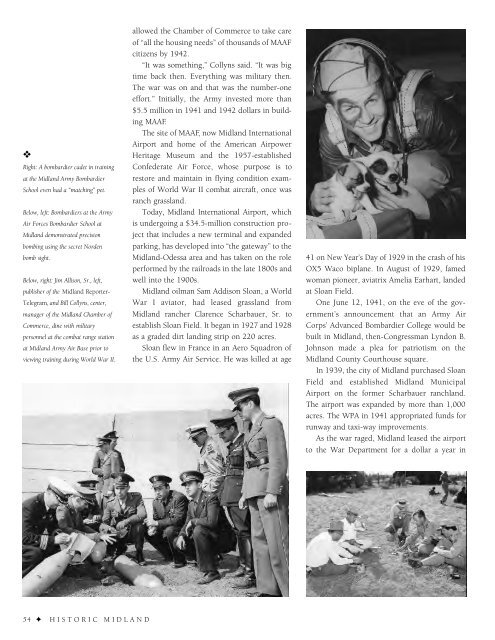Historic Midland
An illustrated history of the Midland County area, paired with the histories of companies, families and organizations that make the region great.
An illustrated history of the Midland County area, paired with the histories of companies, families and organizations that make the region great.
You also want an ePaper? Increase the reach of your titles
YUMPU automatically turns print PDFs into web optimized ePapers that Google loves.
❖<br />
Right: A bombardier cadet in training<br />
at the <strong>Midland</strong> Army Bombardier<br />
School even had a “matching” pet.<br />
Below, left: Bombardiers at the Army<br />
Air Forces Bombardier School at<br />
<strong>Midland</strong> demonstrated precision<br />
bombing using the secret Norden<br />
bomb sight.<br />
Below, right: Jim Allison, Sr., left,<br />
publisher of the <strong>Midland</strong> Reporter-<br />
Telegram, and Bill Collyns, center,<br />
manager of the <strong>Midland</strong> Chamber of<br />
Commerce, dine with military<br />
personnel at the combat range station<br />
at <strong>Midland</strong> Army Air Base prior to<br />
viewing training during World War II.<br />
allowed the Chamber of Commerce to take care<br />
of “all the housing needs” of thousands of MAAF<br />
citizens by 1942.<br />
“It was something,” Collyns said. “It was big<br />
time back then. Everything was military then.<br />
The war was on and that was the number-one<br />
effort.” Initially, the Army invested more than<br />
$5.5 million in 1941 and 1942 dollars in building<br />
MAAF.<br />
The site of MAAF, now <strong>Midland</strong> International<br />
Airport and home of the American Airpower<br />
Heritage Museum and the 1957-established<br />
Confederate Air Force, whose purpose is to<br />
restore and maintain in flying condition examples<br />
of World War II combat aircraft, once was<br />
ranch grassland.<br />
Today, <strong>Midland</strong> International Airport, which<br />
is undergoing a $34.5-million construction project<br />
that includes a new terminal and expanded<br />
parking, has developed into “the gateway” to the<br />
<strong>Midland</strong>-Odessa area and has taken on the role<br />
performed by the railroads in the late 1800s and<br />
well into the 1900s.<br />
<strong>Midland</strong> oilman Sam Addison Sloan, a World<br />
War I aviator, had leased grassland from<br />
<strong>Midland</strong> rancher Clarence Scharbauer, Sr. to<br />
establish Sloan Field. It began in 1927 and 1928<br />
as a graded dirt landing strip on 220 acres.<br />
Sloan flew in France in an Aero Squadron of<br />
the U.S. Army Air Service. He was killed at age<br />
41 on New Year’s Day of 1929 in the crash of his<br />
OX5 Waco biplane. In August of 1929, famed<br />
woman pioneer, aviatrix Amelia Earhart, landed<br />
at Sloan Field.<br />
One June 12, 1941, on the eve of the government’s<br />
announcement that an Army Air<br />
Corps’ Advanced Bombardier College would be<br />
built in <strong>Midland</strong>, then-Congressman Lyndon B.<br />
Johnson made a plea for patriotism on the<br />
<strong>Midland</strong> County Courthouse square.<br />
In 1939, the city of <strong>Midland</strong> purchased Sloan<br />
Field and established <strong>Midland</strong> Municipal<br />
Airport on the former Scharbauer ranchland.<br />
The airport was expanded by more than 1,000<br />
acres. The WPA in 1941 appropriated funds for<br />
runway and taxi-way improvements.<br />
As the war raged, <strong>Midland</strong> leased the airport<br />
to the War Department for a dollar a year in<br />
54 ✦ HISTORIC MIDLAND
















